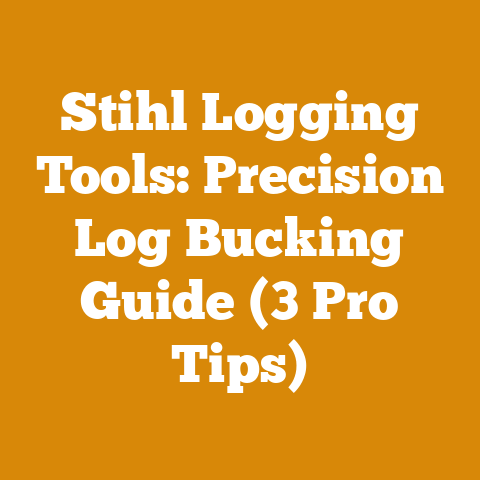Back Boiler for Wood Stove (5 Expert Tips for Efficient Heating)
It was a winter much like any other in the Laurentian mountains of Quebec, Canada. Snow piled high, temperatures plummeted, and the wood stove in my grandfather’s cabin roared day and night. But this year was different. He’d installed a back boiler – a simple, ingenious addition to his trusty wood stove. What followed was a revelation. Not only did the cabin stay warmer than ever before, but the hot water it provided was a game-changer for everything from washing dishes to thawing frozen pipes. Before, heating water meant firing up a separate propane tank, a costly and often inconvenient process. That winter, the back boiler transformed a chore into a seamless, efficient part of our daily routine. It was my first real taste of the power of integrating wood-fired heating with modern living, and it sparked a lifelong fascination with the efficiency and sustainability of wood as a heat source.
Now, decades later, I’ve worked on countless wood processing and firewood preparation projects, from small-scale home setups to larger, more complex systems. In this guide, I want to share my experience and provide you with expert tips on how to efficiently heat your home using a back boiler for your wood stove. We’ll cover everything from understanding the basics to optimizing your system for maximum heat output and safety. Whether you’re a seasoned wood burner or just starting out, this guide will equip you with the knowledge to harness the full potential of this cost-effective and environmentally friendly heating solution.
Back Boiler for Wood Stove: 5 Expert Tips for Efficient Heating
A back boiler, also known as a water jacket or a water-heating stove, is essentially a heat exchanger integrated into or around a wood stove. It captures the heat that would normally escape up the chimney and uses it to heat water. This hot water can then be used for domestic hot water, central heating, or even radiant floor heating. The benefits are clear: reduced reliance on fossil fuels, lower energy bills, and a more sustainable approach to heating.
Before diving into the tips, let’s define some key terms:
- Green Wood: Freshly cut wood that has a high moisture content (typically 50% or higher).
- Seasoned Wood: Wood that has been air-dried to reduce its moisture content (ideally below 20%). Seasoned wood burns much more efficiently and cleanly than green wood.
- BTU (British Thermal Unit): A unit of energy used to measure the heat output of a fuel source.
- Thermal Mass: The ability of a material to absorb and store heat. Materials like concrete, brick, and water have high thermal mass.
- Closed System: A heating system where the water is circulated in a closed loop, preventing it from being exposed to the atmosphere. This requires an expansion tank to accommodate the expansion of water as it heats.
- Open System: A heating system where the water is open to the atmosphere, typically through a vent pipe. This is less common and requires careful monitoring to prevent corrosion and scaling.
Now, let’s get into the 5 expert tips that will help you maximize the efficiency of your back boiler system.
1. Choosing the Right Back Boiler and Wood Stove
The foundation of an efficient back boiler system lies in selecting the right components. Not all back boilers and wood stoves are created equal.
Understanding Your Heating Needs:
Before you even start looking at equipment, take stock of your heating needs. How large is the area you want to heat? What is the climate like in your region? How much hot water do you typically use? Answering these questions will help you determine the appropriate BTU output for your wood stove and the size of the back boiler.
Selecting the Right Wood Stove:
Look for wood stoves specifically designed to be used with back boilers. These stoves typically have a larger firebox and a more efficient combustion system. Consider the following factors:
- BTU Output: Choose a stove with a BTU output that matches your heating needs. A stove that is too small will struggle to heat your home, while a stove that is too large will burn inefficiently and potentially overheat.
- Efficiency Rating: Look for stoves with a high efficiency rating (75% or higher). This indicates that the stove is able to convert a large percentage of the wood’s energy into heat.
- EPA Certification: Ensure that the stove is EPA-certified. This means that it meets strict emissions standards and burns cleanly.
- Firebox Size: A larger firebox allows you to load more wood at once, reducing the frequency of refueling.
- Construction Quality: Choose a stove made from durable materials like cast iron or steel. A well-built stove will last longer and require less maintenance.
Choosing the Right Back Boiler:
The back boiler should be matched to the BTU output of the wood stove and the size of your heating system. Consider these factors:
- Capacity: The capacity of the back boiler (measured in gallons or liters) should be sufficient to meet your hot water demands.
- Material: Back boilers are typically made from steel or copper. Steel is more durable and less expensive, while copper is a better conductor of heat.
- Design: Look for a back boiler with a large surface area for maximum heat transfer. Some back boilers are designed to wrap around the firebox, while others are integrated into the stove’s flue.
- Compatibility: Ensure that the back boiler is compatible with your wood stove and your existing heating system.
Personal Story:
I once worked on a project where a homeowner installed a back boiler that was too small for their wood stove. The result was that the stove was constantly overheating, and the back boiler was not producing enough hot water. After some troubleshooting, we realized that the back boiler simply couldn’t handle the heat output of the stove. We replaced it with a larger unit, and the problem was solved. This experience taught me the importance of carefully matching the back boiler to the wood stove.
Data and Insights:
According to the EPA, certified wood stoves are significantly more efficient and produce less pollution than older, non-certified stoves. A certified stove can burn up to 30% less wood to produce the same amount of heat. This translates to significant savings on fuel costs and a reduced environmental impact.
Tool Specifications:
- Wood Moisture Meter: Use a wood moisture meter to ensure that your firewood is properly seasoned (below 20% moisture content).
- Thermometer: Install a thermometer on your back boiler to monitor the water temperature.
- Multimeter: Use a multimeter to check the electrical connections of your circulator pump and other components.
2. Optimize Your Firewood for Maximum Heat
The type and quality of firewood you burn directly impact the efficiency of your back boiler system. Using seasoned hardwood is crucial for maximizing heat output and minimizing creosote buildup.
Hardwood vs. Softwood:
Hardwoods like oak, maple, ash, and beech are denser than softwoods like pine, fir, and spruce. This means that hardwoods contain more energy per volume and burn longer and hotter. Softwoods, on the other hand, burn quickly and produce more smoke and creosote.
Seasoning Your Firewood:
Seasoning firewood involves drying it to reduce its moisture content. This process typically takes 6-12 months, depending on the type of wood, the climate, and how the wood is stacked. Properly seasoned firewood burns much more efficiently and cleanly than green wood.
Signs of Properly Seasoned Firewood:
- Cracks: Seasoned firewood will typically have cracks in the end grain.
- Weight: Seasoned firewood will be significantly lighter than green wood.
- Sound: When two pieces of seasoned firewood are struck together, they will produce a hollow sound.
- Color: Seasoned firewood will be a dull gray color, while green wood will be a brighter color.
Stacking Your Firewood:
Properly stacking your firewood is essential for efficient seasoning. The following tips will help you stack your firewood for optimal drying:
- Elevate the wood: Stack the wood on pallets or rails to keep it off the ground and allow air to circulate underneath.
- Stack loosely: Leave gaps between the rows of wood to allow air to circulate.
- Cover the top: Cover the top of the woodpile with a tarp or roof to protect it from rain and snow.
- Orient the wood: Stack the wood with the bark side up to help shed water.
- Choose a sunny location: Stack the wood in a sunny location to promote drying.
Personal Story:
I once made the mistake of burning green wood in my wood stove. The result was a smoky, inefficient fire that produced very little heat. The stove also quickly became coated with creosote, which is a fire hazard. I learned my lesson the hard way: always burn seasoned firewood.
Data and Insights:
According to the U.S. Department of Energy, burning seasoned firewood can increase the efficiency of your wood stove by up to 50%. This means that you can heat your home with half as much wood.
Tool Specifications:
- Axe: A high-quality axe is essential for splitting firewood. Look for an axe with a sharp blade and a comfortable handle.
- Log Splitter: A log splitter can make splitting firewood much easier and faster, especially if you are processing large quantities of wood. Hydraulic log splitters are the most powerful and efficient.
- Chainsaw: A chainsaw is useful for felling trees and cutting logs into manageable lengths. Choose a chainsaw with the appropriate bar length and engine size for the size of the trees you will be cutting. I recommend a chainsaw with a bar length of 18-20 inches for most firewood processing tasks. A 50cc engine provides ample power for most hardwoods.
Case Study:
A local firewood supplier in my area uses a hydraulic log splitter to process large quantities of wood. The splitter can split logs up to 24 inches in diameter and 24 inches in length. This allows the supplier to process wood much faster and more efficiently than they could with an axe. They report that the log splitter has increased their production capacity by over 50%.
3. Install and Maintain Your System Properly
Proper installation and maintenance are crucial for the safe and efficient operation of your back boiler system.
Professional Installation:
While some DIYers may be tempted to install their own back boiler system, I strongly recommend hiring a qualified professional. A professional installer will ensure that the system is installed correctly and safely, and that it meets all local building codes.
Safety Considerations:
- Carbon Monoxide Detectors: Install carbon monoxide detectors in your home to protect against carbon monoxide poisoning.
- Chimney Inspection: Have your chimney inspected and cleaned annually by a qualified professional.
- Pressure Relief Valve: Ensure that your back boiler system is equipped with a pressure relief valve to prevent over-pressurization.
- Temperature and Pressure Gauges: Install temperature and pressure gauges to monitor the system’s performance.
- Emergency Shut-Off: Know where the emergency shut-off valve is located in case of a problem.
Maintenance Schedule:
- Daily: Check the water level in the expansion tank.
- Weekly: Clean the firebox and remove ashes.
- Monthly: Inspect the chimney and flue for creosote buildup.
- Annually: Have the system professionally inspected and serviced.
Personal Story:
I once inspected a back boiler system that had been improperly installed by a homeowner. The system was not properly vented, and carbon monoxide was leaking into the home. Fortunately, the homeowner had installed carbon monoxide detectors, which alerted them to the problem. This incident highlights the importance of professional installation and regular maintenance.
Data and Insights:
According to the National Fire Protection Association (NFPA), chimney fires are a leading cause of residential fires. Regular chimney inspections and cleaning can significantly reduce the risk of a chimney fire.
Tool Specifications:
- Chimney Brush: Use a chimney brush to clean your chimney and flue. Choose a brush that is the correct size and shape for your chimney.
- Creosote Remover: Use a creosote remover to help break down creosote deposits in your chimney.
- Safety Glasses: Always wear safety glasses when working on your back boiler system.
- Gloves: Wear gloves to protect your hands from dirt and grime.
4. Optimize Your Heating System for Efficiency
The way you integrate your back boiler with your existing heating system can significantly impact its efficiency. Consider these factors:
Closed vs. Open Systems:
As mentioned earlier, closed systems are more efficient and require less maintenance than open systems. If possible, convert your existing heating system to a closed system.
Circulator Pump:
A circulator pump is used to circulate the hot water from the back boiler to your radiators or radiant floor heating system. Choose a pump that is sized appropriately for your system. An oversized pump will waste energy, while an undersized pump will not provide enough heat.
Thermostatic Control:
Install a thermostatic control system to regulate the temperature of your home. This will prevent overheating and save energy.
Insulation:
Insulate all pipes and tanks to minimize heat loss. This will help to keep your heating system running efficiently.
Thermal Storage:
Consider adding a thermal storage tank to your system. A thermal storage tank allows you to store excess heat from the back boiler and use it later when the stove is not burning. This can significantly improve the efficiency of your system and reduce your reliance on other heating sources.
Personal Story:
I helped a homeowner install a thermal storage tank in their back boiler system. The tank allowed them to store excess heat from the stove during the day and use it to heat their home at night. This reduced their wood consumption by over 20% and made their home much more comfortable.
Data and Insights:
According to the U.S. Department of Energy, properly insulating your pipes and tanks can reduce heat loss by up to 80%.
Tool Specifications:
- Pipe Insulation: Use pipe insulation to insulate your hot water pipes. Choose insulation with a high R-value (resistance to heat flow).
- Tank Insulation: Use tank insulation to insulate your thermal storage tank.
- Thermostat: Install a programmable thermostat to regulate the temperature of your home.
5. Monitor and Adjust for Peak Performance
The final step in maximizing the efficiency of your back boiler system is to monitor its performance and make adjustments as needed.
Track Your Wood Consumption:
Keep track of how much wood you are burning each day or week. This will help you to identify areas where you can improve your efficiency.
Monitor Water Temperatures:
Monitor the water temperature in your back boiler and thermal storage tank. This will help you to ensure that the system is operating at the optimal temperature.
Adjust Airflow:
Adjust the airflow to your wood stove to optimize combustion. Too much airflow will cause the wood to burn too quickly, while too little airflow will result in incomplete combustion and increased creosote buildup.
Experiment with Different Wood Types:
Experiment with different types of wood to see which ones burn most efficiently in your stove.
Seek Professional Advice:
Don’t hesitate to seek professional advice from a qualified heating contractor. They can help you to troubleshoot problems and optimize your system for peak performance.
Personal Story:
I once spent several weeks experimenting with different airflow settings on my wood stove. I found that by slightly reducing the airflow, I was able to significantly increase the burn time of the wood and reduce the amount of creosote buildup in the chimney.
Data and Insights:
According to the Hearth, Patio & Barbecue Association (HPBA), regular monitoring and adjustment of your wood stove can improve its efficiency by up to 15%.
Tool Specifications:
- Infrared Thermometer: Use an infrared thermometer to measure the surface temperature of your wood stove and chimney.
- Draft Gauge: Use a draft gauge to measure the draft in your chimney.
- Notebook: Keep a notebook to record your wood consumption, water temperatures, and airflow settings.
By following these 5 expert tips, you can maximize the efficiency of your back boiler system and enjoy the benefits of wood-fired heating for years to come. Remember to prioritize safety, invest in quality equipment, and maintain your system regularly.
Strategic Insights:
- Long-Term Investment: Installing a back boiler system is a long-term investment that can pay for itself in energy savings over time.
- Environmental Benefits: Wood-fired heating is a renewable energy source that can help to reduce your carbon footprint.
- Energy Independence: A back boiler system can provide you with greater energy independence and reduce your reliance on fossil fuels.
Next Steps:
- Assess your heating needs and determine the appropriate BTU output for your wood stove and back boiler.
- Research different wood stove and back boiler models and choose the ones that best meet your needs.
- Hire a qualified professional to install your back boiler system.
- Season your firewood properly and stack it in a well-ventilated location.
- Monitor your system’s performance and make adjustments as needed.
With careful planning and execution, you can create an efficient and sustainable heating system that will keep your home warm and comfortable for years to come. Good luck!






